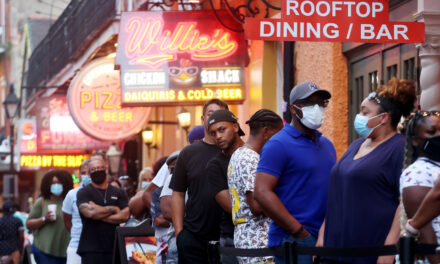
Wall Street Confronts an Uncertain Election Outcome: Live Business Updates

The outcome that many on Wall Street feared but expected emerged on Wednesday, as Election Day failed to produce a clear victor in the U.S. presidential race, leaving investors to wait and watch.
Stock futures swung dramatically between gains and losses throughout the night and into early Wednesday. Trading in futures contracts for the S&P 500 moved between gains and losses nearly 10 times in the 12 hours leading to 6 a.m. Eastern on Wednesday.
The most dramatic market moves came around 2 a.m. Eastern after President Trump said that he had won re-election against Joseph R. Biden Jr. despite the fact that several battleground states had not announced results, and that he would ask the Supreme Court to intervene in the race.
The futures, which tumbled after Mr. Trump’s remarks, recovered some ground to point to a gain of less than half a percent in the S&P 500 when trading begin, while the Dow Jones industrial average was poised for a slight fall.
European markets opened about 1 percent lower and then regained some of their losses as traders set in for what could be a long wait for results.
Susannah Streeter, an analyst at Hargreaves Lansdown said investors were adopting a wait-and-see approach but that Trump’s comments were a reminder that it could be a volatile trading session. Earlier, Asian markets finished mixed after a turbulent ride.
One of the biggest swings was in yields for U.S. Treasury bonds, an indicator of investor nervousness. Yields fell as prices rose, indicating a greater desire to park money in a safe place.
Investors saw a clearer path on Tuesday, when they priced in a relatively quick victory for Mr. Biden, the Democratic candidate. A strong victory for him and his party could set the stage for a large pandemic relief spending package in Washington early next year. That could bolster the economy, fueling consumer spending and cushioning growth even as coronavirus cases surge again. It would also mean big deficits in the near term, potentially pushing longer-term interest rates higher.
Wall Street has been clamoring for such a program for months, but negotiations between the White House and the Democratic leadership in the House of Representatives fizzled out in recent weeks.
Financial markets were whipsawed overnight as traders and pundits saw early returns pointing to a close result, raising the possibility that President Trump could be re-elected, and the Senate remain in Republican control. On one hand, Mr. Trump’s low taxes and limited regulation have been popular among investors. On the other, analysts have been clear that a divided government could hurt the chances for a big spending package. Investors might also be wary that delayed vote counts could lead to a long period of uncertainty.
“You’re not seeing as large a blue wave as had been predicted early on,” said Gregory Daco, chief U.S. economist at Oxford Economics, around 11 p.m. New York time.
In Japan, the Nikkei rose 1.7 percent, but other markets in the region were less ebullient after a turbulent trading day.
The 10-year Treasury yield dropped 10 basis points, or 0.1 percentage points, to 0.79 percent. It is the steepest one-day fall in yields since late March.
Among unscientific indicators, two Chinese stocks went on rides along with the polls based on their names. A company called Wisesoft, whose name in Chinese sounds like “Uncle Trump wisely wins,” jumped more than 7 percent at one point on the stock exchange in the city of Shenzhen.
Another Shenzhen stock, Zhejiang Giuseppe Garment, fell more than 1 percent earlier in the day. Its name in Chinese sounds a little like “Joe Biden” if spoken over a scratchy phone line.

Voters in Florida on Tuesday approved a ballot measure that would raise the state’s minimum wage to $15 by 2026.
Florida becomes the eighth state in the country to enact a minimum wage of $15, according to the National Conference of State Legislatures, but the first of them that Donald Trump carried in the 2016 presidential election. The District of Columbia has also enacted a $15 minimum wage.
Florida’s measure, known as Amendment 2, earned a place on Tuesday’s ballot in December and needed at least 60 percent of the vote to pass. With 99 percent of the vote counted, the measure had slightly more than 61 percent.
Under the measure, the state minimum wage would rise from its current hourly rate of $8.56 to $10 in September, and then increase by $1 every September through 2026. After that, annual increases would be tied to inflation.
A study by the Florida Policy Institute, a think tank backing the increase, found that the higher wage would directly benefit 2.5 million workers in the state.
A number of studies have found that moderate increases in the minimum wage have not led to significant job losses. But economists caution that the effects on employment depend on the size of the increase relative to a city or state’s wage scale.
That could make a $15 minimum wage more costly in a state like Florida, where wages tend to be substantially lower than wages in other states that have enacted a $15 minimum wage.
Oil prices rose Wednesday as the results of the U.S. presidential election remained uncertain. Brent crude, the international benchmark, gained about 2.5 percent, while West Texas Intermediate, the American standard, was up about 2.7 percent.
“The election’s outcome is not really priced in this morning,” said Bjornar Tonhaugen, head of oil markets at Rystad Energy, a consulting firm, in a note on Wednesday. But, he added, traders will be keeping an eye “locked on TV screens.”
Oil prices, which had risen as much as 2 percent earlier in the evening, slumped after President Trump said that he had won the election, despite the fact that several battleground states have not yet reported results. The prices quickly recovered.
With no clear outcome in the United States, traders are reacting to other news including industry data published Tuesday showing a sharp fall in stockpiles of crude oil in the United States. This drop may indicate that economic recovery from the coronavirus pandemic in the world’s largest oil consuming country may be stronger than expected. Concerns had been growing that new lockdowns in countries like France, Germany and Britain might curb oil consumption.
In addition, hopes are increasing that OPEC and Russia may agree to further curb output or at least defer increases that are planned from the beginning of next year.
Over the longer term, analysts say, a victory by Joseph R. Biden Jr. might have negative implications for oil prices. Mr. Biden, for instance, has said he would push for a transition away from oil to greener forms of energy, leading to reduced consumption of fossil fuels. He might also try to revive the nuclear deal with Iran that the Trump administration torpedoed, eventually bringing a flood of Iranian crude back on the market.
President Trump on the other hand has been a strong advocate for the oil industry in the United States, pushing for deregulation and looser environmental standards. Earlier this year he leaned on OPEC and Russia to trim production to defend prices.

California voters on Tuesday approved Proposition 22, a ballot measure that allows gig economy companies like Uber and Lyft to continue treating drivers as independent contractors.
The vote opens a path for the companies to remake labor laws throughout the country.
Uber, Lyft and the delivery service DoorDash designed the measure to exempt the companies from a state labor law that would have forced them to employ drivers and pay for health care, unemployment insurance and other benefits. As a concession to labor advocates, the initiative offers a wage floor and limited benefits to drivers.
The Associated Press projected early Wednesday that Prop. 22 had carried 58 percent of the vote. Proposition 22 faced the strongest opposition in San Francisco, where Uber and Lyft are headquartered, with more than a 19-point deficit. The fight pit labor groups and state lawmakers against ride-hailing and delivery start-ups that spent $200 million in support of the measure.
With the gig work model cemented in California, Uber and other gig economy companies are expected to pursue federal legislation that would protect them from similar employment laws in other states.
“The last 14 months in California have been the most critical point on this issue,” said Bradley Tusk, a venture capitalist who advised Uber on political issues during its early years.
Still, their victory comes as federal lawmakers and officials are increasingly eager to take on big tech. Members of Congress in both parties support cracking down on social media companies and reining in the likes of Amazon and Google. Uber and its gig economy peers could be caught in that anti-tech sentiment.
Share prices in Uber and Lyft jumped in premarket trading on Wednesday after California voters approved a measure that will allow the ride-hailing companies to continue treating drivers as independent contractors.
Uber shares gained as much as 16 percent, and Lyft rose 18 percent.
Both companies help draft the ballot measure, known as Proposition 22, which exempts them from a new state labor law that would have forced them to employ drivers and pay for health care. Uber is expected to pursue federal legislation that would protect it and other gig economy companies from similar employment laws in other states.
The battle over Prop. 22 became hugely expensive, with backers contributing $200 million to a campaign that pitted Uber, Lyft, DoorDash and similar gig economy companies against labor groups and state lawmakers.

Sandwiched between Tuesday’s election and the Friday’s October jobs report, the Federal Reserve is set to announce its November policy decision.
There’s a good chance that the central bank will lay low at Thursday’s meeting, both because of the murky economic outlook and because the Fed is politically independent and will want to avoid inserting itself into the election storyline.
“I don’t think they want to get into anything political — anywhere near anything political,” said Gregory Daco, chief U.S. economist at Oxford Economics. Though Chair Jerome H. Powell is sure to face election-related queries at his webcast news conference, he is likely to dodge them.
“I’m sure he’s preparing in front of a mirror right now to answer some of these questions,” Mr. Daco said.
The Fed slashed interest rates to near-zero in March and has been buying about $120 billion in government-backed bonds per month to soothe markets and support demand. Officials are expected to discuss their future bond buying plans at this meeting, but economists expect them to hold off on major decisions as the economy’s path ahead remains wildly unsettled.
Manufacturing data have shown recent improvement. Spending on goods has been strong, bolstered by savings stashed away earlier in the year even as expanded unemployment benefits have lapsed and small business loans have run dry. Yet the situation could darken as consumers exhaust their savings and coronavirus cases surge, and the pace of job gains is already slowing.
Economists in a Bloomberg survey estimate that employers probably brought back or added 600,000 workers in October, a relatively small number when compared to the millions of Americans still out of work.
Fed officials have historically received key jobs numbers from the White House Council of Economic Advisers ahead of their release on Friday morning. But the secure fax containing that data has typically been sent late on Thursday afternoon, a person familiar with the process said. Officials will not know the October numbers before their meeting.
No matter who is elected, the next president will face an economy that is still reeling after the shutdowns last spring. Some areas have bounced back, but others remain deeply depressed, and millions of Americans are still out of work.

















